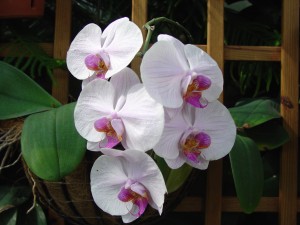At one time, growing orchids was a hobby that only rich doctors, lawyers and fictional detectives could afford. Today, the very affordable “moth orchids” (Phalaenopsis spp.) are commonly available at supermarkets and big hardware chain stores at reasonable prices. They’re easy to grow and produce large showy flowers which bloom for two or more months.
Moth orchids can spend most of the spring and summer months outdoors beneath the dense leafy canopy of a shade tree. They come back indoors in early fall here in the Southern Appalachian region (USDA zones 6 and 7).
The winter season in most home is a tough environment for growing orchids. Orchids are plant epiphytes which grow on tree trunks and branches in the humid tropics. Their thick fleshy roots draw moisture from the air and various surfaces around the roots. Orchids are comfortable in home temperatures between 60 and 80 °F., but low room humidity is hostile to orchids. Room humidity as low as 10% is commonplace during the winter.
The bathroom and kitchen are the most humid rooms in the home, but outdoor light is usually limited. Moth orchids crave bright light but not direct sunlight. Sunlight intensity is weak and daylength is short in the Northern hemisphere between November through February.
Orchids are planted in special potting mixes containing coarse bark, sphagnum peat moss and perlite. Some mixes add charcoal for added drainage and to filter impurities. A good orchid potting mix should retain moisture for only a few days as their fleshy roots easily rot if the growing media is saturated for many days. Never leave a potted moth orchid standing in water.
Fertilize spring thru fall weekly with a high phosphorus based soluble house plant fertilizer. However, package directions are too strong for orchids. Use only half the amount recommended and feed weekly. Orchids are fertilized once monthly from December thru February. After repotting, do not fertilize for 2-3 weeks.


 Posted in
Posted in 
